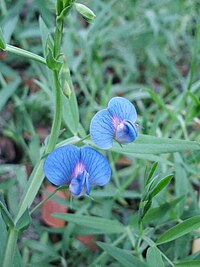
Fortification of durum wheat semolina with detoxified matri (Lathyrus sativus) flour to improve the nutritional properties of pasta
Sign Up to like & getrecommendations! Published in 2018 at "Journal of Food Science and Technology"
DOI: 10.1007/s13197-018-3126-x
Abstract: Durum wheat semolina (DWS) can be enriched with legume flours to produce more nutritious but high-quality pasta. DWS was substituted with detoxified matri (Lathyrus sativus) flour (DMF) at 5–25%, which in spaghetti increased the levels… read more here.
Keywords: detoxified matri; lathyrus sativus; wheat semolina; sativus flour ... See more keywords

In situ effects of Lathyrus sativus- PGPR to remediate and restore quality and fertility of Pb and Cd polluted soils.
Sign Up to like & getrecommendations! Published in 2020 at "Ecotoxicology and environmental safety"
DOI: 10.1016/j.ecoenv.2020.110260
Abstract: Rehabilitation of heavy metals contaminated soils using association between legumes and beneficial rhizospheric microorganisms such as plant growth-promoting bacteria (PGPR) is a major challenge in agronomy. The present study focuses on assessing the impact of… read more here.
Keywords: quality; pgpr; lathyrus sativus; situ effects ... See more keywords

Genome-wide identification of drought-responsive miRNAs in grass pea (Lathyrus sativus L.)
Sign Up to like & getrecommendations! Published in 2020 at "Plant Gene"
DOI: 10.1016/j.plgene.2019.100210
Abstract: Abstract The grass pea (Lathyrus sativus L.) is an attractive legume which grows traditionally in drought-stricken, rain-fed and poor fertile soils. Globally drought is a major constraint for agriculture. Regulatory mechanism such as non-coding RNA… read more here.
Keywords: drought; grass; lathyrus sativus; pea lathyrus ... See more keywords

Lathyrus sativus resistance against the existing and emerging pathogens Erysiphe pisi and Erysiphe trifolii: A case of commonalities or total discrepancy?
Sign Up to like & getrecommendations! Published in 2023 at "Phytopathology"
DOI: 10.1094/phyto-06-22-0227-fi
Abstract: Powdery mildew in Lathyrus sativus (grass pea), is commonly caused by Erysiphe pisi, the causal agent of pea powdery mildew. Erysiphe trifolii could also impose an additional threat to grass pea, as it does to… read more here.
Keywords: resistance; pea; grass pea; trifolii ... See more keywords

Drought tolerance in some populations of grass pea (Lathyrus sativus L.)
Sign Up to like & getrecommendations! Published in 2017 at "Legume Research"
DOI: 10.18805/lr-346
Abstract: In Algeria, the genus Lathyrus is cultivated mainly for grain production (food) and also used as fodder (animal feed). Lathyrus sativus L. or grass pea has a good resistance to drought, salinity and flooding. However,… read more here.
Keywords: sativus drought; seed; grass pea; lathyrus sativus ... See more keywords